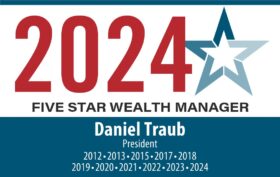For about the past year and a half, much of the investing and economic worlds have been expecting a recession (generally defined as two successive quarters of falling GDP).
Interest rates had been rising at the beginning of 2022 when Russia invaded Ukraine.
The invasion further stoked inflation fears, which were already inflamed by foreign tariffs, reductions in immigration, low unemployment, supply chain disruptions, and money pouring into the economy due to the CARES Act, the Paycheck Protection Program, the American Rescue Plan, and the Infrastructure Bill.
Inflation leads to higher interest rates, and higher interest rates can lead to a decrease in economic activity (i.e. lower GDP).
But no recession came.
In March 2022, the Fed started raising interest rates to stem inflation.
But no recession came.
In July 2022, the yield curve inverted.
The yield curve inverts when the yield on 2-year Treasurys is higher than the yield on 10-year Treasurys. In theory an inverted yield curve means the market is more pessimistic near term than long term. An inverted yield curve is often, though not always, a precursor of a recession.
But no recession came.
In the Spring of 2023 mid-sized banks started to fail. Surely this would tip the economy into recession!
But no recession came.
Could a recession still occur?
The snarky economist in me says “Of course, there will be a recession. 100% guaranteed. I can also guarantee that the Dow will hit 50,000 at some point in the future.”
My real answer (for the near to intermediate term): There could still be a recession. But it is not guaranteed.
People forget there is a lot going right with economy. Unemployment remains low. People are spending money. The Infrastructure Bill will keep many people employed for a long time. After peaking at 9.1% in June 2022, inflation (as measured by the consumer price index) has dropped to 4%, the lowest since March 2021.
Maybe, just maybe, many of the inflationary pressures were transient after all?!
Much like Chicken Little, perhaps the chorus of market observers calling for a recession was at the least premature, if not simply wrong.
With all this as a backdrop, you may be wondering how the stock market performed.
Just fine, thank you!
For the second quarter the S&P 500 was up 8.7%, driven largely by technology stocks which were up 15%. Electric Grid stocks had a good quarter as well (+8%). Happily, these are two of our tactical overweights within Lifestyle accounts.
Beyond that, none of the sectors I follow (and I follow a lot!) came close to the S&P 500: Mid-caps and small caps +5%, healthcare and international +3%, financial +2.5, real estate +2%, infrastructure and energy 0%, and utilities -2%.
Returns on the fixed income (i.e. bonds) front were less exciting.
For the quarter the BarCap Aggregate Bond Index was down 0.8%. Inflation bonds (-1.5%) and global bonds (-0.8%) also had negative returns for the quarter.
If you wanted to make money in bonds in the second quarter you had to look outside the box, so to speak. Bank loan bonds (+2.5%), high yield bonds (+1.5%), and emerging market bonds (+2%) all had attractive returns.
Tempo Financial Advisors’ 2nd Quarter Investment Performance
Let’s start with the Tempo Dynamic Income and Diversified Income Programs, which were both the lowest returning of Tempo’s four investment strategies and the only ones to beat their benchmarks!
For the quarter Tempo Dynamic Income and Diversified Income returned +1.9% and +0.9%, respectively. This compares to a return on the BarCap Agg of -0.8%. That is outperformance of 2.7% and 1.7% in a single quarter.
And it gets better the longer you look.
For the one year ending 6/30/2023, Tempo Dynamic Income, Diversified Income and the BarCap Agg returned +4%, +3.8% and -0.9%.
For the three years ending 6/30/2023 Tempo Dynamic Income, Tempo Diversified Income and the BarCap Agg had average annual returns of +2%, +2.8%, and -4%!!!
Average annual returns of +2% and +2.8% may not seem exciting, but to generate positive returns that beat the benchmark by 6% a year on average over a three-year span of negative benchmark returns is everything I could hope for.
Tempo Dynamic Growth returned 2.9% for the second quarter. A decent showing from an absolute return perspective, though about half a percent below its benchmark.
Tempo Lifestyle had the highest returns among Tempo’s four investment strategies in the second quarter. As is always the case with well-diversified portfolios, some of our positions performed better than others.
Highlights in equity include excellent performance in two of our strategic overweights (technology and electric grid). On the lower risk side of the ledger, standouts include fixed income and alternative funds such as bank loan bonds, short term high yield bonds, relative value arbitrage, multi-alternative and long/short equity all of which contributed positive returns in the midst of a negative period for the Agg.
Lowlights include underperformance of three of our equity sector overweights: healthcare, financial, and infrastructure.
When you put the highs and the lows together, Tempo Lifestyle returns were in line with benchmarks and ranged from 3.7% for conservative accounts to 5% for aggressive accounts.
Tempo on the Move
During the month of August, I will transition from my long-time office in Framingham to my new home at 75 2nd Avenue in Needham. Hope to see you there!
Reminder
Please contact us if there has been a change in your financial circumstances that would warrant a fresh perspective on your portfolio.
Daniel J. Traub

